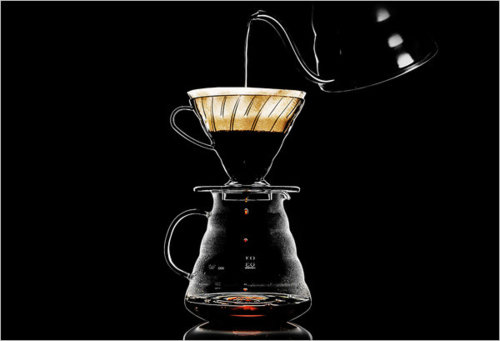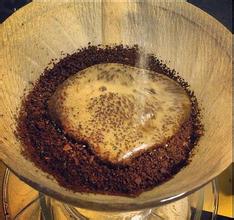Coffee brewing method: introduction to the skills and matters needing attention in the production of Japanese hand-made coffee
Japanese-style hand-brewed coffee seems simple, in fact, every step of the operation will lead to different coffee taste or subtle changes, and need to master the basic principles of making Japanese-style hand-brewed coffee and some variable factors when making Japanese-style hand-brewed coffee.
The following content is my own summary of several points after communicating with many well-known coffee teachers in Chongqing. I hope you can provide some reference for making hand-brewed coffee for friends who like coffee.
First of all, let's know the utensils and materials needed to make Japanese hand-brewed coffee.
Raw materials for making hand-brewed coffee: water, coffee beans.
Hand-brewed coffee making appliances: hand-brewed cup (first invented by a German woman, so single-hole hand-brewed cup is also called Melita cup), hand-brewed filter paper (similar to the straw paper used by people in the 1980s, good filtration, rough surface can absorb coffee powder, is the best choice for making hand-brewed coffee), Hand washing pot (feels like an Arabic pot, and there is a story about Aladdin's lamp in Arabia, so this kind of pot used for hand washing is called Latin pot.), Coffee pot (for holding filtered coffee), electronic scale, thermometer, single-serve coffee cup.
The use of the above utensils and materials will affect the taste of the coffee made.
The following is an analysis of one by one for friends to pay attention to when making Japanese hand brewed coffee.
One, water.
More than 90% of a cup of hand-brewed coffee is water, so water is naturally the primary material factor affecting the taste of coffee. The impact of water is mainly manifested in two aspects:
1, water temperature.
The temperature of hand-brewed coffee is generally maintained between 88-93 degrees. If the water temperature is too high, it is easy to extract the bitter components of coffee, resulting in bitter coffee, loss of acidity, lack of freshness and brightness. On the contrary, if the water temperature is too low, it is easy to cause insufficient extraction, making coffee sour and dull.
2, the ratio of water to coffee powder
This principle applies to all aqueous solutions, i.e. the greater the ratio, the greater the concentration of the solution. Therefore, the same amount of coffee powder here, the greater the amount of water, the smaller the coffee concentration, the lighter and softer, the smaller the amount of water, the greater the coffee concentration, the stronger the taste.
Second, the degree of grinding.
The grinding degree of coffee powder determines the contact area between coffee powder and water during brewing and the degree of easy extraction. The finer the coffee powder is ground, the easier its ingredients are extracted and the heavier the taste, but the grinding details are easy to extract too much bitter ingredients and lose their original acidity. On the contrary, the coarser the grinding degree, the lighter and softer the coffee taste, and the appropriate coarseness can well express the acidity of coffee.
Third, extraction time.
Japanese hand-brewed coffee extraction also has strict requirements in terms of timing. Generally, the extraction time of one cup is about 1 minute and 30 seconds, two cups are about 2 minutes to 2 minutes and 30 seconds, and three cups are about 3 minutes and no more than 3 minutes and 30 seconds. Leaving this time limit, extraction time is too short, it is easy to cause insufficient extraction, taste bland, too long, it is easy to extract excessive, coffee taste more bitter and miscellaneous ingredients.
IV. Extraction equipment.
The biggest impact here is mainly the difference between filters. Coffee Ming home commonly used filters are mainly single-hole Melita, three-hole Kareta and conical kono three kinds.
In contrast, coffee brewed with caritas is lighter and softer, with obvious acidity and a clean and refreshing taste. Melita makes coffee aroma more intense, taste more rich and stable. The kono method shows a softer aroma and richer taste, a more pronounced sweetness, and a smoother and more balanced taste.
Fifth, brew water flow.
Making coffee by hand is a "kung fu activity", and this "kung fu" is mainly manifested in the regulation of water flow. During the process of hand soaking, it is necessary to maintain the height of water flow, the thickness of water flow, and the uniformity and stability of water flow speed. Any deficiency will affect the richness of taste and the balance of taste.
1. Height of water flow.
The height of the water flow is generally kept at a distance of about 3 or 4 cm from the coffee powder plane. If the water flow is too high, the impact force is too large, which is easy to destroy the internal balance of the coffee powder, causing the miscellaneous flavor to be extracted and the taste to be unbalanced. Low water flow becomes "bubble" coffee, water flow can not pass through coffee powder smoothly, easy to cause coffee powder part "ponding", excessive extraction.
2, water flow thickness, water flow speed.
If you want to inject the same amount of water at the same time, you mainly rely on adjusting the thickness of the water flow and the speed of the water flow. Generally, the coarser the water flow, the faster the rotation speed, the extracted coffee taste tends to be light and soft, suitable for light roasted beans; the finer the water flow, the slower the rotation speed, the more fully extracted, and the coffee taste is relatively strong. However, the thickness and speed of the water flow should be properly controlled. Too coarse and too fast water flow is easy to extract insufficient, coffee is light and tasteless or only shows a single bitter taste; too fine and too slow water flow is easy to cause excessive extraction, and coffee tastes dull and bitter.
Six, the human factor.
Hand brewed coffee for a long time, have to have some "idealism". Personally, I think hand-washed hand-brewed, so here people are the key factor. Coffee brewed carelessly and coffee brewed wholeheartedly taste absolutely different, because the former infuses water and the latter infuses heart. Coffee brewed with the same care, care, and tension and coffee brewed with ease and confidence are two flavors-of course! If the coffee maker himself is nervous, not confident, not assured of his own operation, then how can the coffee powder below easily release all its aroma and taste! Therefore, to sum up the above points, if the first five points can be grasped well, you can make the taste of hand-brewed coffee, but it is not enough to have taste alone. This is to add the sixth point, to turn the hand into the heart, so that the coffee can have soul, life and vitality, and can be delicious.
Source:
Coffee wet blog
Important Notice :
前街咖啡 FrontStreet Coffee has moved to new addredd:
FrontStreet Coffee Address: 315,Donghua East Road,GuangZhou
Tel:020 38364473
- Prev

Coffee brewing method: basic knowledge of hand-brewed coffee making
Among the many methods of making coffee, the hand brewing method not only can play the rich and fresh aroma of coffee in taste, maintain the pure taste and rich and soft taste of coffee, maximize the personality of coffee, but also has the advantages of simple operation, easy learning and easy management. But this does not mean that hand brewed coffee is brewed at will without any foundation,
- Next

Coffee brewing mode: several common mistakes and correct operation methods of hand-made coffee
A good cup of hand-brewed coffee can taste different levels of details such as sour, fragrant and sweet. It is refreshing and burden-free. As long as you touch it, you can't extricate yourself from such meticulous flavor changes. Many friends said, clearly follow the steps, why still can not make a good cup of hand-made coffee? Now the editor exposes the common mistakes of making coffee from three angles!
Related
- What is the meaning of lactic acid fermentation with coffee bean treatment?
- How to judge the state of foam by sound?
- How does the latte pull out the unicorn pattern? Come to get for a little trick to improve the flower pull!
- Will flower pulling affect the taste of the latte?
- Do you know the history of coffee?
- The difference between honey treatment and sun washing what is raisin honey treatment?
- What kind of milk can a novice use to make coffee foam to keep the foam longer? The correct method and skills of milking tutorial sharing
- Why do washed coffee beans taste sour? Flavor characteristics of washed Coffee
- Introduction to the skill of how to practice the size and height of water injection around the circle of hand-brewed coffee
- How do beginners practice coffee flower drawing from scratch?

